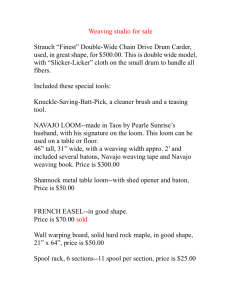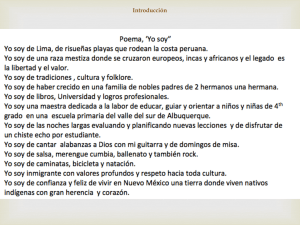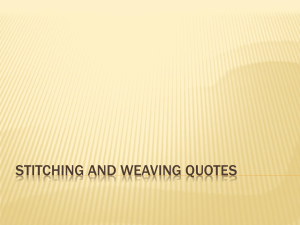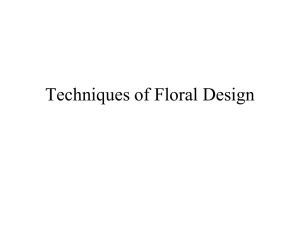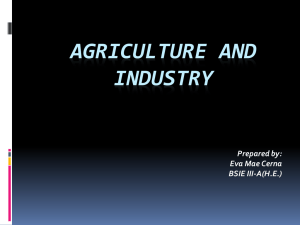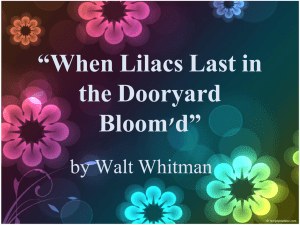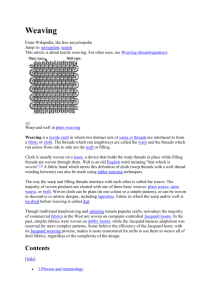Pre-print - Edinburgh Research Explorer
advertisement
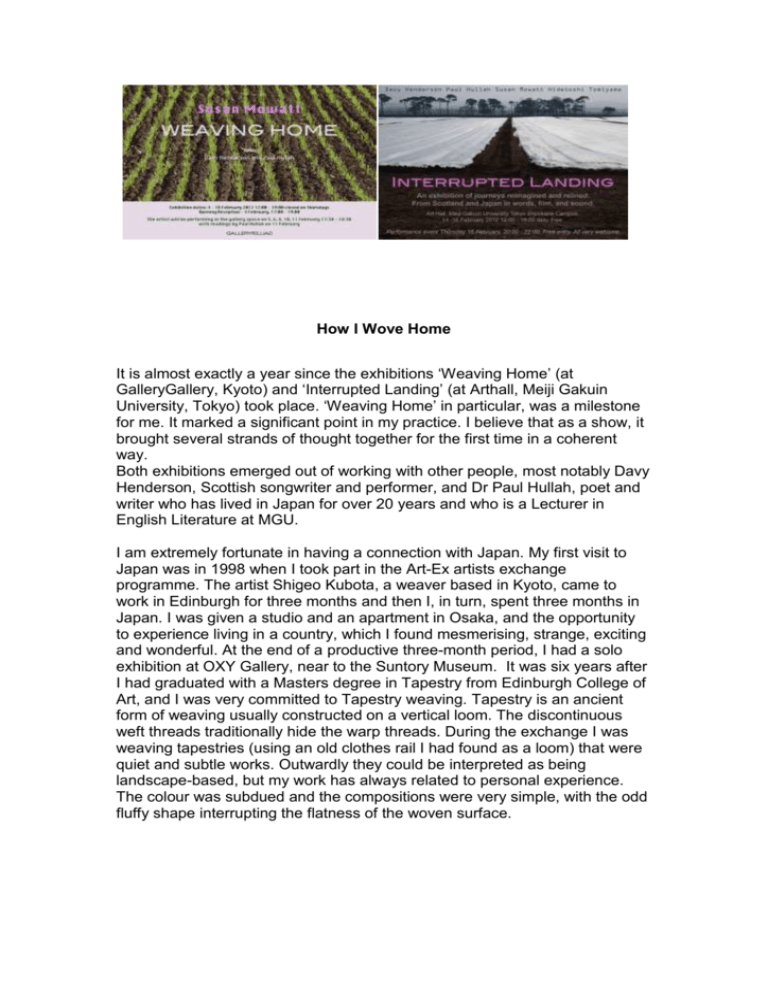
How I Wove Home It is almost exactly a year since the exhibitions ‘Weaving Home’ (at GalleryGallery, Kyoto) and ‘Interrupted Landing’ (at Arthall, Meiji Gakuin University, Tokyo) took place. ‘Weaving Home’ in particular, was a milestone for me. It marked a significant point in my practice. I believe that as a show, it brought several strands of thought together for the first time in a coherent way. Both exhibitions emerged out of working with other people, most notably Davy Henderson, Scottish songwriter and performer, and Dr Paul Hullah, poet and writer who has lived in Japan for over 20 years and who is a Lecturer in English Literature at MGU. I am extremely fortunate in having a connection with Japan. My first visit to Japan was in 1998 when I took part in the Art-Ex artists exchange programme. The artist Shigeo Kubota, a weaver based in Kyoto, came to work in Edinburgh for three months and then I, in turn, spent three months in Japan. I was given a studio and an apartment in Osaka, and the opportunity to experience living in a country, which I found mesmerising, strange, exciting and wonderful. At the end of a productive three-month period, I had a solo exhibition at OXY Gallery, near to the Suntory Museum. It was six years after I had graduated with a Masters degree in Tapestry from Edinburgh College of Art, and I was very committed to Tapestry weaving. Tapestry is an ancient form of weaving usually constructed on a vertical loom. The discontinuous weft threads traditionally hide the warp threads. During the exchange I was weaving tapestries (using an old clothes rail I had found as a loom) that were quiet and subtle works. Outwardly they could be interpreted as being landscape-based, but my work has always related to personal experience. The colour was subdued and the compositions were very simple, with the odd fluffy shape interrupting the flatness of the woven surface. Detail of Gold Spot, 1998 Susan Mowatt Brown Spots on Grey, 1998 Someone at the opening reception commented that the tapestries reminded them of Japanese raked gravel gardens. I remember feeling astonished at the time that I, myself, had not made the connection, but in the months to follow it all started to make sense. The gravel gardens of Kyoto had been a real highlight of my visit, with the garden at Ryoan-ji making a particularly strong impact. The indication of the slow, rhythmic process that had taken place was something that I enjoyed very much. Another memory, which used to crop up in the years to follow, was the sight of all the little stones that I had seen in temples (Jizo) with the bibs tied around them. I remember finding them incredibly moving and beautiful, wrapped in the individually stitched fabrics. It was definitely the start of an attachment to Japan as a country, and each time I have visited since, specific little sightings or moments make gentle impacts. With time, they seem to ‘feed’ and influence the work I make. I wove many tapestries, large and small, for about 17 years. Latterly, however, it became rather a chore. Hours and hours would be spent creating works for exhibitions and I seldom felt satisfied at the end of it. Slowly I realised something very simple: I did not particularly like what I was doing. I was no longer challenged or excited. Things had to change. My thoughts turned to Annie Albers, the most renowned weaver to have come out of the Bauhaus, that powerhouse of 20th century Art and Design. The most interesting thing about her for me, is that despite her success and all the beautiful, innovative weavings and designs she created, she left it all behind. She stopped producing woven pieces, turning instead (amongst other things) to drawing and printmaking. She eventually found weaving far too limiting a medium for her ideas. I identified completely with this and following in her footsteps, I decided to change the way I worked. This turning point coincided with another major event that had happened in my life. In 2002 and 2005 respectively, I gave birth to two daughters. Suddenly I no longer had hours and hours to spend in the studio. I was teaching at Edinburgh College of Art, and with two young children to look after, the time available to make my own work became very limited. To attempt to make work that demanded so much time seemed nonsensical. I started to really question what tapestry was, what it meant to me and what (if any) relevance it had in the twenty first century. In the collection of Aberdeen Art Gallery in Scotland, there is a painting by JW Waterhouse of Penelope, the most famous weaver of all time. In Homer’s Odyssey, the famous Greek poem written at the end of the 8 th century, she was the wife of Odysseus and was famous for her cleverness and for her faithfulness to her husband. When Odysseus fails to return after the Trojan War, Penelope is bothered all the time by potential suitors. In order to keep them at bay, she declares that when she finishes weaving a shroud for her father-in-law she will make a decision about whom to marry. Penelope and the Suitors, John William Waterhouse, 1912 But she is clever because as the painting depicts, her suitors and her ladiesin-waiting witness her weaving the shroud by day, but at night when no one is looking, she un-weaves it. This delaying tactic lasts for three years. Undoubtedly she had a motive, but like me, I think she must have enjoyed the actual process to spend years of her life doing it and undoing it without actually producing anything. It is something that is hard to shake off. “Once a weaver always a weaver”, it is said. From a personal point of view, this has something to do with the repetitious process, the act of weaving itself. Importantly, I also embrace the slowness, the implication of time invested. It seems to be an activity very much at odds with the world as we know it today. There is another reason why I find this painting of Penelope intriguing. It shows her engrossed in the act of weaving, but also present in the picture are her ladies and her suitors, who become the onlookers. This gives the scene an air of performance. Recognising this was a trigger point for me. In order to think or develop ideas in the studio, I draw or I make small exploratory pieces. By 2009 I had made many drawings of weaving, rather than weaving itself. I was considering weaving as an act, rather than a means to produce a ‘thing’. I was thinking about the very basics of tapestry weaving: the various yarns; weights and colours; how one yarn stops and the other starts. At one point I was asked to write a statement for an exhibition, and never really enjoying that exercise, I came up with: A length of yarn has two ends: a beginning and an end, or vice versa. I liked this simple notion. I started to think about weaving and un-weaving as a kind of performance. I had been interested in a work by the American artist Anne Wilson. It was titled Wind Up; Walking the Warp, and was performed in a gallery in Chicago in 2008. It took nine participants six-days of walking, counting, rolling, and winding to put the warp threads on the frame, and then it was left as a piece for the remainder of the show. Anne Wilson Wind Up: Walking the Warp Rhona Hoffman Gallery, Chicago 2008 I thought it was a very strong piece of work and I was also interested in the idea that after the show is over, there is nothing left. No work to store and no ‘product’ to buy. I had always been uncomfortable with the fact that tapestries are so expensive because it takes so long to make them. Historically Tapestries were commissioned as a means to display the status, wealth and grandeur of their patron. Today, Tapestry still attracts a rather ‘bourgeois’ audience. In a world already bursting with people and their discarded belongings, it’s important to me as an artist to take on board the impact of producing even more ‘stuff’. In 2009, Richard Wright won the Turner prize (a major art award in UK). He studied at Edinburgh College of Art and is an artist who decorates architectural spaces with intricate designs and patterns. Often the works are very short lived and painted over after the exhibition. They are equal in scale to the largest tapestries and take a very long time to produce. He uses a cartoon, which is also akin to tapestry. The fact that he allows them to exist only briefly is inspiring and something that I admire. It seemed to be the opposite of how people regard the ‘preciousness’ of tapestries, and how I had kept mine rolled up for years, redundant in the corner of my studio. The ephemeral quality of the work adds to its beauty. Richard Wright, Turner Prize 2009, Tate Britain So began a period in the studio where I was weaving and un-weaving lines in space, and tentatively starting to think about some kind of performative element in the work. The actual act of making was also very important. In this age of instant gratification, when being able to function normally in daily life is becoming more and more dependent on screen-based activity, and where populations are regarded primarily as potential consumers, I worry about my children. I worry that some of my daughters’ friends do not like to play outside in the garden because they are afraid of bees and other insects. It scares me that a lot of children do not have an understanding of where food comes from and refuse imperfect fruit. Often on the train home from work I notice that nobody is looking out of the window at the breathtaking landscape we are rushing through or incredible, brief sunsets that are taking place outside, but are all plugged in instead to electrical devices. Which brings me back to Annie Albers. She once wrote that “Life today is very bewildering………we have developed our receptivity and have neglected our own formative impulse. It is no accident that nervous breakdowns occur more often in our civilization than in those where creative power had a natural outlet in daily activities. And this fact leads to a suggestion: we must come down to earth from the clouds where we live in vagueness, and experience the most real thing there is: material” What may be surprising is that she wrote this in 1938, long, long before any notion that a virtual world would one day become a reality. I wanted to make work that addressed these issues and that highlighted the importance of making things and connecting to real material in the real world. And then I had a moment of clarity. In 2008, during another visit to Kyoto with a colleague and 20 students (when we worked together with Machiko Agano and her students at Seika University), I had often frequented a second hand shop near to where we were staying. I had bought one particular photograph and hung it on the wall in my studio when I came home, without really knowing why. It never really offered much, but despite this I never took it down. If you look closely, you see a man walking down a gentle sloping hill. Further back there is another person walking up the hill, and beyond that there are other figures that look like they are standing still or sitting down. I realised that the lines I was weaving in the studio were also like peoples lives. The two lines I used for warp meant that weaving on them produced a similar rhythm to walking. And each pass was like night and day: time passing. After my friend Paul Hullah lost his wife in 2009, we decided to make a book together. For me it was a way of helping him at a very difficult time in his life, and I think for him, it provided him with a focus and a way of dealing with his grief. We had previously collaborated on a book of poetry and drawings in 2002. Paul wrote poems responding to the death of his wife but as a result of subsequent events, the poems also grew to deal positively with ‘connections’ made by people: the importance of friendship and the need for continuity, cooperation and mutual understanding. homing. A book about love and loss. Poetry by Paul Hullah, Drawings by Susan Mowatt ‘Homing’ is a book of poetry and drawings, which was published in 2011 by Word Power Books in Edinburgh. Ultimately, we like to think it is a book about hope, and moving forward. It marks the passing of a life, but it is very much about new beginnings. The drawings and the poems come together very well and compliment each other. Although I was responding to the poems Paul had written, it felt like we had reached the same place even though we had used our own totally separate routes to get there. In the 2012 exhibition ‘Weaving Home’ in GalleryGallery, woven lines were installed in the space, and at certain times during the week I performed in the space weaving (or un-weaving). Yellow line/yellow socks GalleryGallery 2012 In an adjoining space was an audio piece with lines from some of the poems read aloud in English, but also translated beautifully into Japanese by Hidetoshi Tomiyama, a colleague of Pauls at MGU. There was one more element to the show that excited me as it was a new direction in my work and has opened up many other possibilities and ways of working. Early in 2011, Davy Henderson and I were invited to work together and be part of a show titled ‘Vegetable Loves’. For the exhibition, we were asked to respond to another poem: Andrew Marvell’s ‘To His Coy Mistress’, written in the seventeenth century with the line: My vegetable love should grow Vaster than empires, and more slow; In the poem, a man tells the woman he loves how he would love her had they an unlimited amount of time stretching out in front of them. But then he talks about how brief life is, how short their time on earth actually is, and he ends by basically telling her that they have to stop messing around and playing games and just get on with it. Working with somebody else provides the possibility of trying out something new, and Davy and I had often talked about making films. In Autumn I started to film fields around where we live, just south of Edinburgh, fields we have always loved looking at and walking in amongst. Some had cabbages, some brussel sprouts or potatoes that had already been harvested, but then in late December when we were going through a particularly cold, icy spell, I filmed this particular field several times. I liked the fact that it was in an in-between state. It was hard to tell if it had been ploughed, or planted. Was it the end of something or the start of something? The lines reminded me, of course, of warp, and the slowness and time invested in the soil were just there. Still from Coleslaw, 2011 Davy then made up some music for the piece, using only the musical notes C-A-B-B-A-G-E We called this short film Coleslaw (which is a type of salad made of carrots, onions and cabbages). It was a really important piece for me to make, because I felt it spoke clearly about lots of things that I had been trying to say, but could not using different media. I liked the fact that a little magic appeared out of it’s slowness, the fact that it was soil and that nothing really happens: it is just the earth and the sun. Mindful of the imminent exhibition at Gallery Gallery, I started to film in and around the countryside of East Lothian, sometimes on family walks and sometimes on my own. This footage was edited down to only five films that were to be included in ‘Weaving Home’. Davy in turn made up the music, enhancing each one and making every piece very distinctive and complete. Stills from Ants and Tractor, 2012 In the film ‘Ants’, a silhouette shows a colony of ants working, travelling backwards and forwards across blades of grass. In ‘Tractor’, fast moving cars and lorries form the backdrop to a contrasting, slow-moving tractor that travels across the top of a recently ploughed field. Meanwhile birds and insects are flying past and the air is filled with the drone of the traffic noise, with the bird song and buzzing of insects on top. In all the films, references to weaving and lines are there, but somehow the films are able to speak of other things, too. These films were also shown in the exhibition ‘Interrupted Landing’, interspersed with sound works by Paul and Hidetoshi Tomiyama. Lines from some of the ‘Homing’ poems were read aloud, sometimes with translated lines interwoven and spoken in Japanese. Presented on a large monitor in a blacked out gallery space it became a sombre and moving way to encounter the poetry. Yet it was uplifting, too. It was a simple way of presenting our ideas. Poets have used Tapestry as a metaphor for life for centuries. It was fitting that the work was conceived of and made in Scotland, then shown in Japan. We all have shared experiences. Art has the ability to transcend cultural and geographical boundaries. Lines on the landscape mark the rhythms and repetition of daily life. As Paul Hullah said, “We are all here, but we are on our way to somewhere else as well.” Susan Mowatt January 2013
